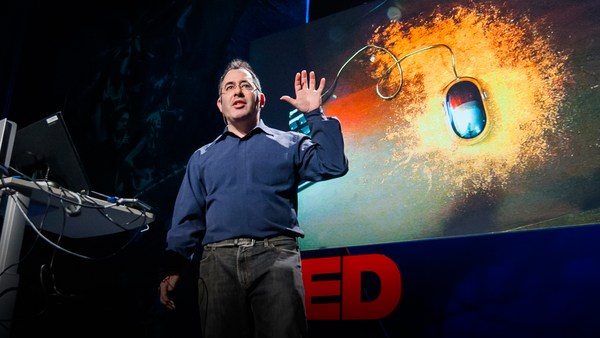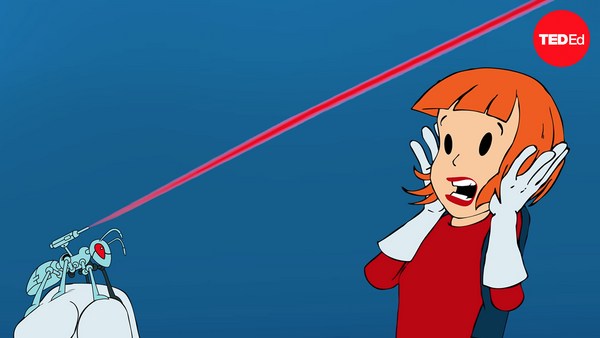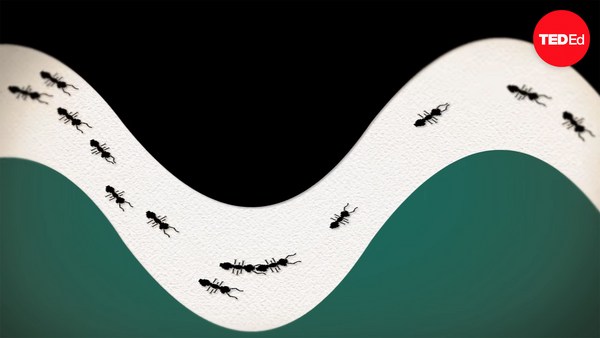There's an old saying, "Just because you can't see something, doesn't mean it's not there." My work is -- it's a reflection of myself. What I wanted to do is to show the world that the little things can be the biggest things. We all seem to think that, you know, if we look down on the ground, there's nothing there. And we use the word "nothing." Nothing doesn't exist, because there is always something. My mother told me that, when I was a child, that I should always respect the little things.
What made me do this work? I shall go into my story. This all started when I was age five. What made me do it? At school, I will admit this: academically, I couldn't express myself. So I was, more or less, classed as "nothing." My world was seen as less. So I decided I didn't really want to be a part of that world. I thought, I need to retreat into something else. So when my mother used to take me to school, she thought I was at school, and I used to do a U-turn, when her back was turned, and run off and hide in the shed at the back of the garden.
Now, the one time I was in the shed, and my mother suspected something, thinking I was at school. My mother was like the woman in Tom and Jerry. So you'd just see her feet. (Laughter) So I was hiding in the shed, like that. And all of a sudden ... And then I saw her legs. And then she said -- grabbed me like that, because my mother was quite big -- and she lifted me up and she says, "How come you're not at school?" I told her I couldn't face it because the way the teacher was treating me, ridiculing me, and using me as an example of failure. So I told her. At that age, obviously, I couldn't express it that way, but I told her I didn't feel right. And then she just said, "You're going back to school tomorrow." And walked off. And I didn't expect that, because I expected one of these ... But I didn't get it.
So I'm sitting there thinking. And as I looked down on the ground, I noticed there was some ants running around. And I went into this little fantasy world. And I thought, "These ants, are they looking for the queen ant? Or do they need somewhere to live?" So I thought "Perhaps, if I made these ants some apartments, they'll move in." (Laughter) So I did. And how I set about that, I got some splinters of wood. And I sliced the little splinters of wood with a broken shard of glass, constructed this little apartment. Well it looked like a little shanty shed when I'd finished. But I thought, perhaps the ant won't know, it'll probably move in. And so they did. That was a bit crude, at the time. And I made all these little apartments and little merry-go-rounds, seesaws and swings, little ladders. And then I encouraged the ants to come 'round by putting sugar and things like that. And then I sat down and all the ants came along. And all I could hear was "Is this for us?"
(Laughter)
And I say, "Yes, they're all for you." And they moved in, and decided not to pay me any rent. (Laughter) And from there I was watching this little world. It became part of me.
When I discovered that I had this gift, I wanted to experiment with this world that we can't see. So I realized that there was more to life than just everything that we see around us that's huge. So I started to educate myself on this molecular level. And as I got older, I continued. I showed my mother. My mother told me to take it smaller.
Now I shall show you something here. And I'll explain. As you can see, that's a pinhead.
(Laughter)
(Applause)
Now that is called the Huf Haus. The gentleman who commissioned me to do this was a gentleman called Peter Huf. And he says to me "Willard, can you put my house on a pinhead?"
(Laughter)
So I say, "How are you going to fit in there?"
(Laughter)
And then he said to me, "I don't believe you can do it. Can you really do it?"
And I says, "Well, try me." And then he said, "But I don't believe that you can do this." So I said, "OK."
So, to cut a long story short, I went home, went underneath the microscope, and I crushed up a piece of glass, crushed it up. And underneath the microscope there were splinters of glass. Some of them were quite jagged. So I was crushing up these pieces of glass, which, as you can see, that's the actual frame of the house. And the actual roof is made up of a fiber, which I found in my sister's old teddy bear. (Laughter) So I got the teddy bear and I said, "Do you mind if I pull out one of your fibers?" So I did. And I looked at it beneath the microscope. And some of it was flat. So I decided to slice these up with the tool that I make by -- I sharpen the end of a needle into a blade. And then I actually slow down my whole nervous system. And then I work between my heartbeat, I have one-and-a-half seconds to actually move. And at the same time I have to watch I don't inhale my own work, at the same time. (Laughter) (Applause) Because that has happened to me.
(Laughter)
So what I did, like I said, come back to the glass. I found these little bits of glass. And I had to make them square. So I'm thinking "How can I do this?" So what I did, I got an oilstone. Broke the edge of an oilstone off. And what I did, I took pieces of glass. And I started to rub them. I used a little tweezer which I made from a hair clip. And I built rubber around the end of the tweezer so it wouldn't crush the glass. And then I started rubbing, very very gently, till some of the edges were quite square. And then I constructed it. And how I constructed it, is by making grooves in the top of the pinhead. And then pushing the glass in with its own friction. And as I was doing it, what happened? The instrument that I used turned into a catapult. And it went like this ... And then that was it.
(Laughter)
Gone. So I'm thinking, "Mr. Huf isn't going to be very happy when I told him his house has gone to another, into the atmosphere somewhere." So to cut the story short, I decided that I had to go back and do it. So I found some more. And I decided to, sort of, construct it very, very slowly, holding my breath, working between my heartbeat, and making sure everything is leveled. Because it's such a small sculpture, nothing can go wrong. And I decided to build it up. Then I used fibers out of my jumper, which I held and stretched. And made the beams going around the house. And the actual windows and the balcony had to be sort of constructed. I used a money spider's web to actually attach certain things, which sent me insane. But I managed to do it. And when I finished it, I came back the next day. I noticed that the house was occupied. Have we ever heard of a dust mite? Darren dust mite and his family moved in.
(Laughter)
So basically I'd completed the house. And there you are.
(Applause)
(Laughter)
Right. As you can see, Bart Simpson is having a little argument. I think they're arguing about the space on the pin. There's not enough room for the two of them. So I didn't think he was going to throw Bart off. I think he was just warning him actually. But this one was made out of a nylon tag out of my shirt. What I did, I plucked the tag out and put it underneath the microscope. I used the needle which has got a slight blade on the end. Can anybody see the blade on the end of that needle?
Audience: No.
WW: So what I did is the same process where I just kind of hold my breath and just work away very, very slowly, manipulating the plastic, cutting it, because it behaves different. Whenever you work on that level, things behave different. Because it's on this molecular level things change and they act different. And sometimes they turn into little catapults and things go up in the air. And, you know, all different things happen. But I had to make a little barrier, going around it, out of cellophane, to stop it moving. Then static electricity set in. And it went ... And I'm trying to remove it. And the static is interfering with everything. So there is sweat dripping off my head, because I have to carve Homer Simpson like that, in that position. And after I've cut out the shape, then I have to make sure that there is room for Bart's neck.
So after I've done the same thing, then I have to paint it. And after I've actually sculpted them, I have to paint them. I experimented with a -- I found a dead fly. And I plucked the hair off the fly's head. Decided to make a paintbrush. (Laughter) But I would never do it to a living fly. (Laughter) Because I've heard a fly in pain. And they go "Meow! Ow!" Even though they get on our nerves, I would never kill an insect because, "All creatures great and small" -- there is a hymn that says that. So what I decided to do is to pluck fine hair out of my face. And I looked at it underneath the microscope. That was the paintbrush. And whilst I'm painting I have to be very careful, because the paint starts to turn into little blobs. And it starts to dry very quickly. So I have to be very quick. If I'm not, it will end up looking not like what it's supposed to look like. It could end up looking like Humpty Dumpty or somebody else. So I have to be very very careful.
This one took me approximately, I would say, six to seven weeks. My work, rough estimate, sometimes five, six to seven weeks; you can't always anticipate. (Applause) As you can see, that's Charlton Heston brought down to size. (Laughter) He says to me, "Willard" -- You can see him saying, "Why me?" I says, "I enjoyed your film. That's why." As you can see, there's an aphid fly there. That's just to show the scale and the actual size of the sculpture. I would say it probably measures ... a quarter of a millimeter. In America they say a period stop. So say if you cut a period stop in half, a full stop, that's about the size of the whole thing. It's made -- the chariot is made of gold.
And Charlton Heston is made of a floating fiber, which I took out of the air. When the sunlight comes through the window you see these little fibers. And what I normally do is walk 'round a room -- (Laughter) -- trying to find one. And then I put it underneath the microscope. I remember one time I was doing it, and the window was open. And there was a lady standing by the bus stop. And she saw me walking around like this. (Laughter) And then she looked at me. And then I went ... And then she went, "Hmm, OK, he's not mad." Yeah, to actually do this thing -- the actual chariot is made of gold. I had a 24-karat gold ring. And I cut off a little flake of gold. And I bent it 'round, and made it into the chariot. And the horse is made from nylon. And the spider's web is for the reins on the horse. To get the symmetrical shape of the horse was very difficult, because I had to get the horse to rear up and look as though it was in some kind of action.
When I did this one, a gentleman seen it and said to me, "There's no way you can do this, you must have used some kind of machine. There's no way a man can do that. It must be a machine." So I says, "OK then, if you say it's a machine ..." (Laughter) (Applause) That one took me approximately six weeks. (Applause)
The most famous statue in the world. This one, I would say, was a serious challenge. (Laughter) Because I had to put the torch on the top. That one is, more or less, the same type of process. The bottom of it is carved from a grain of sand, because I wanted to get a bit of the stone effect. I used a microscopic shard of diamond to actually carve the actual base. Well, I can look at this one and I can be very proud of this, because that statue has always sort of kept an image in my head of, you know, the beginning of people coming to America. So it's sort of Ellis Island, and seeing America for the first time. And that's the first thing they saw. So I wanted to have that little image. And this is it. (Laughter)
And we all know that is the Hulk. I wanted to create movement in the eye of a needle. Because we know we see needles, but people aren't familiar with the eye of a needle apart from putting a thread through it. So I broke the needle. And made a needle look like the Hulk's broken it. It's -- I had to make little holes in the base of the needle, to shove his feet in. So most of my work, I don't use glue. They go in with their own friction. And that's how I managed to do it. As you can see, he's looking at the moment. He's got a little grimace on his face. And his mouth must be probably about three microns. So the eyes are probably about one micron or something.
That ship there, that's made from 24-karat gold. And I normally rig it with the web of a money spider. But I had to rig it with strands of glue. Because the web of the spider, it was sending me insane, because I couldn't get the web to move off. And that's 24-karat gold. And it's constructed. I built it. Constructed each plank of gold. And the whole thing is sort of symmetrical. The flag had to be made out of little strands of gold. It's almost like doing a surgical operation to get this thing right. (Applause)
As you can see, dressage. (Laughter) It's something I wanted to do just to show how I could get the symmetrical shape. The actual rigging on the reins on the horse are made from the same sort of thing. And that was done with a particle from my shirt. And the pinhead I've made green around there by scraping the particles off a green shirt and then pressed onto the needle. It's very painstaking work, but the best things come in small packages.
(Laughter)
Bruno Giussani: Willard Wigan!
(Applause)





